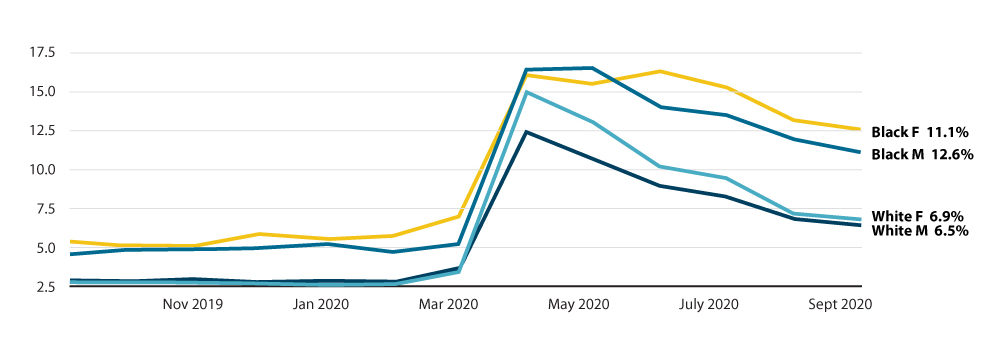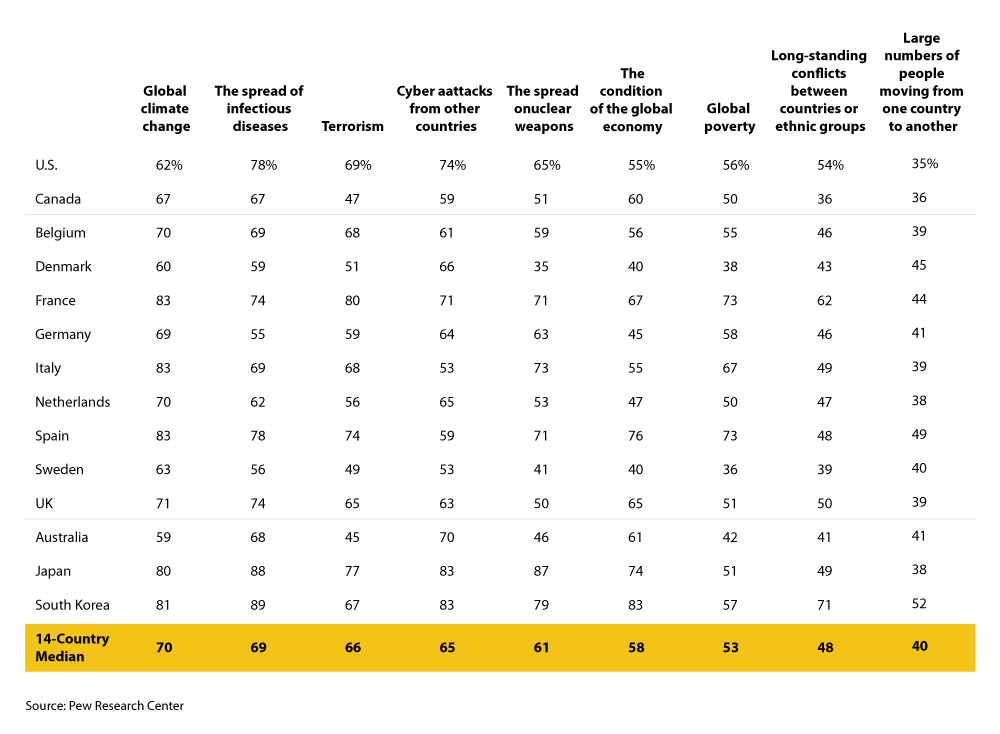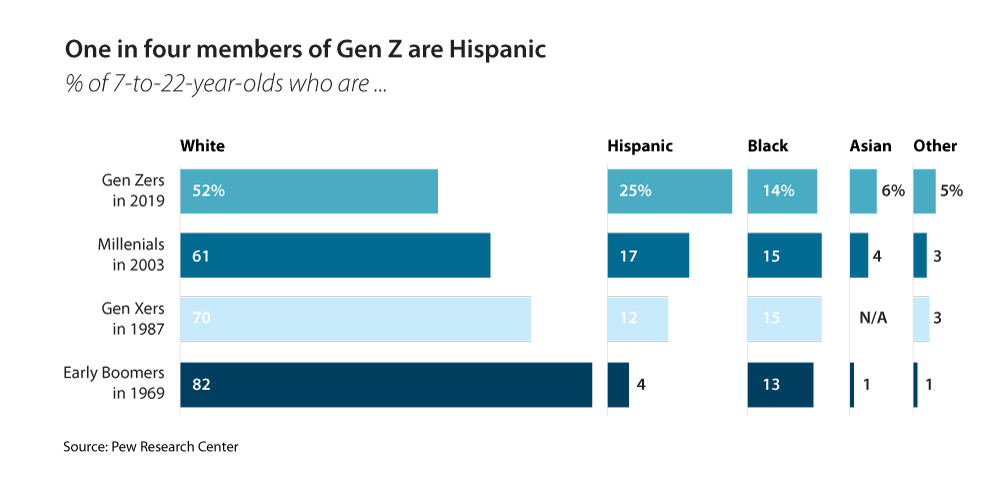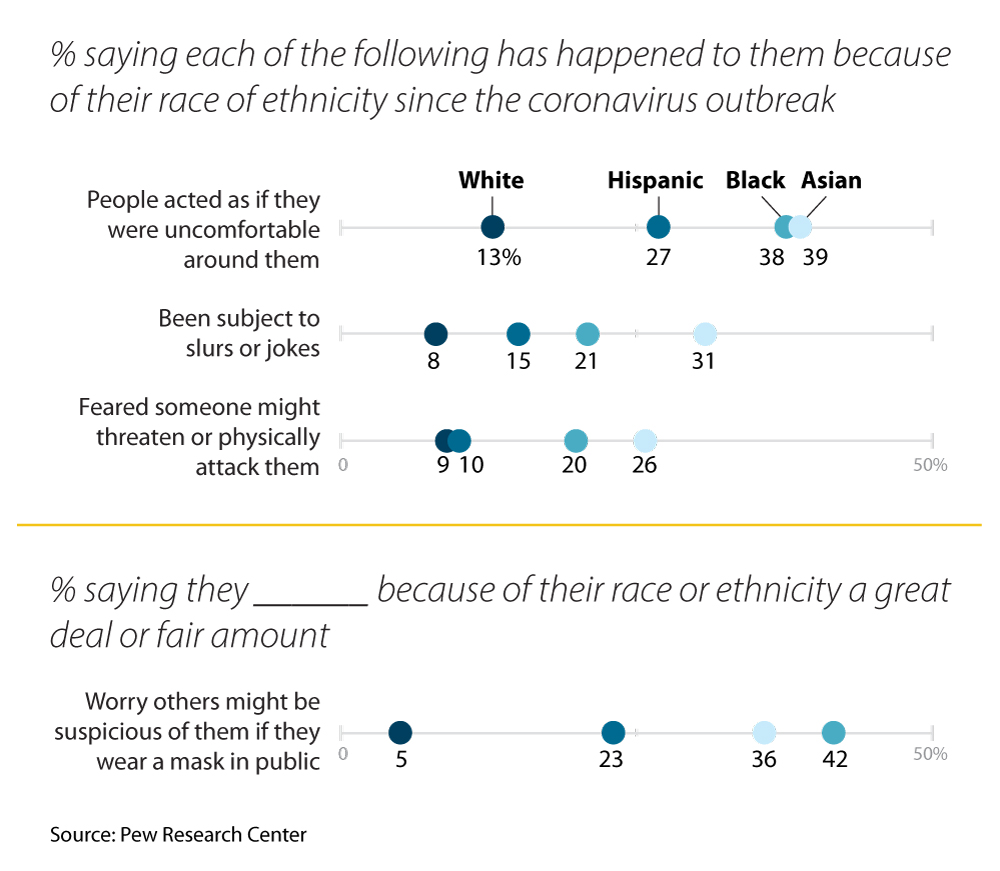Social trends facing business in 2021 and beyond

Editor’s Note: This article is part of a series on external trends impacting small and midsize businesses in 2021. In Part 2, we study social trends in business.
To find the most recent social trends, check out our article: Social Trends Impacting Business in 2022 & Beyond.
COVID-19, social injustice and the election have tested management teams’ ability to operate within an evolving social contract. In this post, we look beyond these historic events at social trends that will impact business in 2021 and beyond. Any discussion of U.S. social issues must acknowledge the divides that have been magnified over the last few months.
Other 2021 trends
Part 1: Ecological trends facing business in 2021 and beyond
Part 3: Technology trends facing business in 2021 and beyond
Part 4: Economic trends facing business in 2021 and beyond
Unemployment
After a peak in April, unemployment rates have declined over the last six months, declining to 6.9% in October 2020. This is still significantly above pre-pandemic rates. Yet the recovery in terms of employment has been uneven:
U.S. Unemployment By Race and Gender1

Unemployment among black Americans is much higher than white Americans, but the gap has closed dramatically over the last 10 years. In 2010, black male unemployment reached 19%, before reaching a low of around 5% in 2019. In September, black male unemployment was 12.6%.
That said, unemployment rate is a poor measure of employment as it does not factor in labor participation rates. Over the last several months, a disproportionate number of women have stopped seeking employment due to needing to care for family members as the result of the pandemic. A federal stimulus package that directs funds to the unemployed is expected, but the timing is uncertain.
Healthcare
Even before the pandemic, the U.S. healthcare system was under significant strain. According to the Centers for Disease Control and Prevention, U.S. life expectancy fell in 2017 for the third year in a row. The U.S. has high levels of heart disease, respiratory problems, cancer and diabetes, which are all considered underlying conditions that can make people more susceptible to the coronavirus.
The aging of America is creating an imbalance in healthcare capacity. The financial burden is shifting from insurance companies to government. Healthcare now represents 18% of GNP, and costs continue to outpace inflation. Healthcare premiums rose 4% this year to $21,342, with the average worker paying 25% of their premium.
The Medicare system is underfunded and ill-prepared to cope with the millions of Americans who will need skilled nursing and specialized care. There are over 6 million Americans with dementia — a number that is growing at an alarming rate.
We are now aware of the devastating effects of infectious disease, and flaws in our healthcare system have been exposed. The medical community is having an identity crisis, with the realization that spending focuses on reactive care in lieu of preventive care.
There are millions of Americans in underserved rural areas, and providers are pivoting into new business models such as retail clinics and tele-medicine that can help meet demand.
The impact of the Supreme Court decision on the Affordable Care Act, and potential legislation to be introduced by the Biden administration are unknown. While early indications are of reasonable premium increases in 2021, one would expect employers to take on significantly higher health care costs in the long term.
The role of business in society
As 2020 has unfolded, business leaders have been under a microscope. Capitalists are seeing the world through a new lens.
Last year, Business Roundtable — representing 181 top U.S. CEOs — issued a statement on the “purpose of the corporation,” suggesting that corporations have responsibilities beyond profit and included an ethos of how leaders govern and manage. It has become clear that the invisible hand yields the world’s most efficient economic engine, but is not effective in eliminating bias. This year, leaders were reminded of the need to put employees ahead of profit.
Businesses are under pressure on all fronts — declining revenue and profit, risks to their employees, and greater expectations placed on them by society. Pew Research Center studies highlight the most important societal issues in the U.S. compared to other countries (as ranked by their residents):

Income inequality
Wage inequality is not only troubling from a fairness standpoint, but because of its significant economic consequences. The International Monetary Fund (IMF) has shone a light on a “synchronized slowdown” in the world’s economy, in effect because of the growing spread between the “haves” and “have-nots.” In particular, the IMF points to declining global trade as a result of protectionist policies around the world.
This is a polarizing issue in the U.S. The left points to the fact that between 1970 and now, middle-income households produced 62% of the nation’s income. Today they produce 43%. According to the Federal Reserve, white Americans hold 91% of the nation’s wealth compared to 4% for black Americans. Yet in a data point that is often misreported, the U.S. progressive tax system results in the top 5% of Americans paying 59% of taxes, creating a disparity that makes taxing the rich further a shallow solution to a complex problem.2 Our economy cannot prosper if the lower income earners don’t have sufficient spending power.
Impacts on recruiting
These issues are material to business leaders, especially as the unemployment rate declines and the war on talent comes back into focus. Younger workers are proactively researching employer positions on equality, use of renewable energy and other social issues.
According to Glassdoor, factors considered by new recruits include compensation, mission, values and vision, and why the company is a great place to work. According to Gallup, 87% of job applicants assess their potential career progression with their new employer.
In an age of digital transformation, online reputation and employee branding carry more weight, and employers have become more proactive in communicating their stance on social issues.
Real estate and the great U.S. migration
Where people are looking for jobs is also shifting.
Online job openings have declined by 30% or more in San Francisco, San Jose, New York, Seattle, Boston, Chicago and Portland. Many of these cities were also the most dramatically impacted by the pandemic and reported the greatest strains on their healthcare systems. The Council on Criminal Justice found the homicide rate was up 53% in major U.S. cities in July and August compared to last year.3
It’s not surprising that the trend toward migrating to large cities has been reversed during the pandemic. Cities with dense technology, academic and medical sectors like Austin, Denver and Raleigh have the highest percentage of people working virtually and are attracting talent.
Meanwhile, the U.S. housing imbalance has only worsened. While apartment rent prices in many U.S. cities (inhabited by hourly service workers) have yielded double-digit declines, housing affordability remains a crisis.4 Amid the massive shift to remote work, technology companies cut pay for employees who have left Silicon Valley. Microsoft and others announced permanent plans for their employees to work remotely.
In September, the inventory of home resales declined by 39%, which is fueling higher prices — up 11% from the prior year.5 In Q2, the U.S. had the lowest percentage of affordable housing in history (60%), with the average U.S. home price exceeding $300,000.
Average values are up 10% in Phoenix, 5% in Denver and 6% in San Diego over the prior year. In New York, prices in August were down 0.1%.6 Yet demographic trends aren’t as simple as people moving from urban to rural. The migration pattern before COVID-19 centered on people moving from the Northeast and Midwest to the Southeast and West in a quest for a better quality of life. Five of the top 10 Gen Z destinations are in Texas. For Millennials, Colorado and Florida are hotbeds.7
Changing demographics
Pre-pandemic, Millennials and Generation Z (born after ‘96) were the focus of many recruiters. In March, half of Gen Z-ers had lost their jobs or taken a pay cut. Not only has the pandemic been uneven in its effects on women, minorities and the poor, but it has also had a deeper impact on the younger generations.
Millennials and Gen Z will continue to be the focus of recruiters and marketers as the breadwinners of tomorrow. Younger populations are much more diverse (one in four are Hispanic), which has deep implications for both employers and marketers.

Digitization
The confluence of COVID-19, social injustice and digital transformation have permanently altered how brands engage with their customers. Customers are actively looking for brands that align with their values. For example, 86% of consumers value authenticity as a trait in the brands they select.8
To suggest that consumers have simply moved from retail to ecommerce understates the fundamental shifts in behavior. Today’s customers demand instantaneous, self-serve online engagement. Eighty-one percent of consumers are frustrated by support interactions on email or phone — an indicator of shifting expectations.
Consumers are no longer loyal to one retailer or channel. While 96% of Americans shop online, 65% of their budget is still intended to be spent instore. In an omni-channel world, value propositions have shifted to new variables such as shipping costs and returns.
Social media is also undergoing dynamic shifts. In a time when we are bombarded by messaging and our attention span is short, marketers are focused on ephemeral content (content that disappears shortly after it is posted, such as Snapchat and Instagram stories).9 Video and influencer marketing continue to rise. Technology companies, under attack from both the left and the right, will be under greater scrutiny to comply with new privacy standards.
B2B marketers are using social media as a hub for knowledge bases and customer service. These technologies are also enabling greater geo-targeting so markets can meet customers where they are.
Education
U.S. colleges and universities are in crisis. Even the most prestigious universities have not been immune — Harvard’s enrollment is down 20% for the fall semester as many students are taking gap years.10 Many small, private universities who had relied on international students are being hit particularly hard.11 Inexplicably, U.S. universities are holding the line on fees even though most have gone entirely virtual.
In addition to online classes, other fundamental shifts in higher education are underway. In lieu of a fully staffed facility, rock star professors will have the opportunity to teach online at multiple institutions. While community colleges saw demand increases in recent years, state institutions are under significant fiscal strain.
Students are also looking to complete micro-credentials so they can acquire specific skills in a market that suddenly tipped supply and demand. Employers will use flexible work arrangements for recruits whose life plans are altered.
Remote learning is emerging as an opportunity both for schools and employers. Learning management systems were a hot sector over the last decade, but they haven’t fulfilled their promise, as organizations have had difficulty providing useful blended learning solutions. Augmented reality will be commonplace, supplemented by highly scalable online solutions.
The collision of COVID-19, social injustice and our relationships
The inequities exposed during the pandemic and social injustice have been well reported. All employers should be acutely aware that the crisis has only exacerbated pre-existing prejudices in the workplace. For example, the comfort level of wearing masks differs dramatically by race:

In creating office protocols, employers need to be aware of deeply rooted biases, beliefs and fears that may vary greatly from one worker to the next.
The widespread impact of COVID-19 put unprecedented pressure on American families. Irrespective of race, 38% of American families have just three months of living expenses in savings.12
To stem the tide of our societal problems, we will have to work together as one. In our strategy practice, we witnessed that employers with strong workplace cultures outperformed others this year, and even increased their employee net promotor scores.
As private companies plan for 2021 and beyond, they need to be more aware of the pressure that families are under today. They must understand their responsibility to ensure that employees have productive work environments where they can be the best version of themselves.
References
1St Louis Federal Reserve September 2020
2Tax Foundation
3Vox.com
4New York and San Francisco Can’t Assume They’ll Bounce Back, by Noah Smith – Bloomberg
5Realtor.com
6Squawk Box
7The consumer is changing, but perhaps not how you think – Deloitte Insights
8Digital Trends for 2020 Every Brand Should Know – Khoros
9Social Media Trends for 2020 and Beyond
10Bloomberg Businessweek September 26, 2020
11Gig It
12Survey: 53% of Americans Live Paycheck to Paycheck – Magnify Money
Also by this author
Category : Economic / Future Trends

